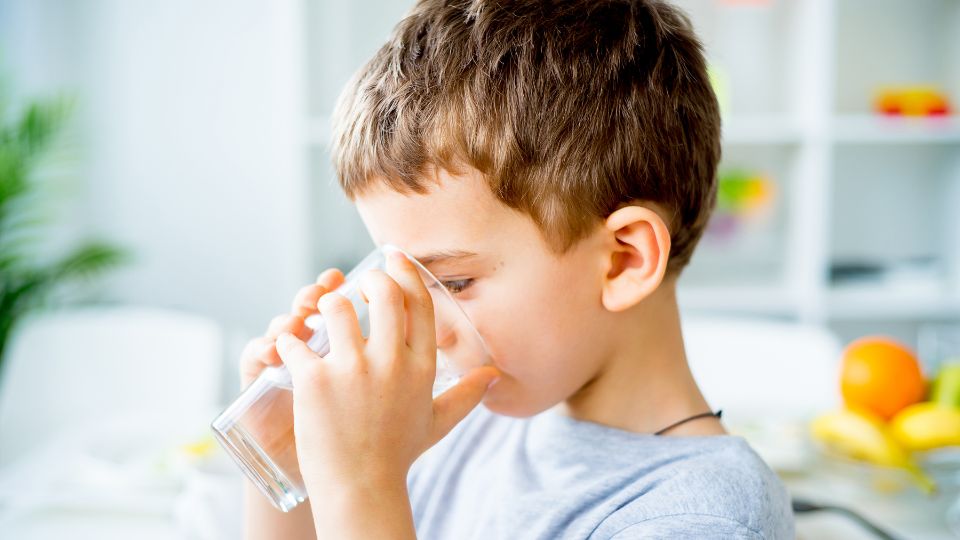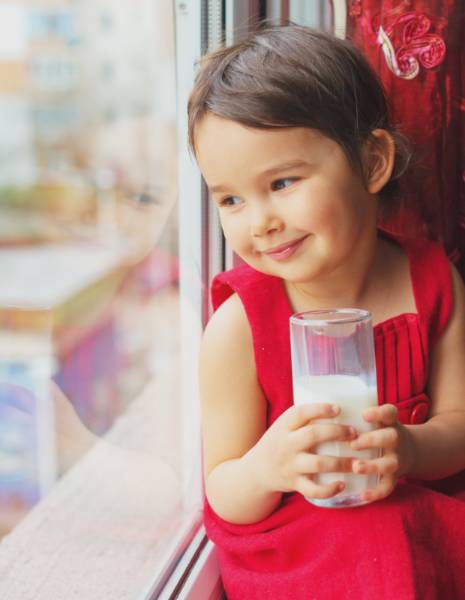Is Your Child Hydrated?

Did you know that over 75% of children do not meet the recommended fluid intake each day (Drewnowski et al., 2013)? Water is the best fluid children can drink. It is essential for all functions in the body to work at their ideal level, yet most children do not drink nearly enough (Gibson, 2013). Water is constantly being used for normal bodily functions and is lost through urine, feces, skin, and breathing (Gibson, 2013). Water can also be lost each day through various activities, sweating, and as a result of different illnesses (D’Anci et al., 2006). Due to the important role and many uses of water in the body, it is crucial that children stay hydrated.

A body is properly hydrated when it has adequate amounts of water to perform at its best (Faizan & Rouster, 2021). The amount of water a child needs depends on a variety of different factors, such as activity level, age, biological sex, and environmental temperature (D’Anci et al., 2006; Institute of Medicine, 2011). Ensuring that children consume adequate amounts of fluid will help their bodies function better and can lead to a healthy habit of drinking water as an adult (Bottin et al., 2019). In this fact sheet, we will discuss daily fluid requirements and barriers and tips for staying hydrated. We will also explain what dehydration is, risk and impact among children, and how to recognize dehydration warning signs.
Daily Fluid Requirements

Fluid needs are dependent upon a child’s age and biological sex, with needs increasing as they age (Institute of Medicine, 2011). On average, about 25% of the total fluid intake needed comes from foods and the other 75% comes from fluids (Gibson, 2013; Suh & Kayouras, 2019). Certain foods and drinks are higher in water content than others. Some foods that have a high water content include cucumbers, tomatoes, spinach, honeydew, broccoli, oranges, and blueberries (Jaarsma, 2021). These foods can be incorporated into snacks or meals. Other drinks that have a high water content include milk, vegetable juice, 100% fruit juice, and sports drinks (European Hydration Institute, 2013). While juice is a good option for water consumption, it is recommended that children limit intake depending on their age (Heyman et al., 2017). Children ages 1 to 3 should consume no more than 4 ounces of juice a day, children ages 4 to 6 should consume 4 to 6 ounces a day, and children 7 to 18 should limit juice intake to 8 ounces a day (Heyman et al., 2017). Water and milk are the most nutritious options for children and should be their primary sources of fluids. Table 1 includes information on the total amount of fluid needed for each biological sex and the specific ages.
Table 1. Daily Fluid Requirements for Children
| Age | Biological sex | Daily fluid needs |
|---|---|---|
| 1 to 3 years | Girls and boys | 5.5 cups/day |
| 4 to 8 years | Girls and boys | 7 cups/day |
| 9 to 13 years | Girls | 9 cups/day |
| 9 to 13 years | Boys | 10 cups/day |
| 14 to 18 years | Girls | 10 cups/day |
| 14 to 18 years | Boys | 14 cups/day |
Barriers and Tips to Stay Hydrated

There are many barriers that prevent children from drinking enough water (Gibson, 2013). The school schedule can be one barrier as students may have limited access to water or the bathroom. Children may also be less likely to drink water during the school day because it is not the “cool” thing to do (Gibson, 2013). Furthermore, children often get caught up in what they are doing so they simply forget they need to drink (Gibson, 2013). All these factors may result in children consuming less fluid than their bodies need to function at their highest ability. Luckily, there are many helpful tips to help keep children hydrated, which include (Bottin et al., 2019; Gibson, 2013):
- Offering water regularly
- Being a positive example of drinking water (making sure you are consuming water frequently)
- Establishing a water routine (having water with meals and snacks, taking breaks when playing to take a drink)
- Making water readily accessible (having cups/water bottles reachable, showing children how to use water dispensers/ faucets)
- Making water fun by adding fruit, straws, etc.
- Always packing a water bottle in the child’s school bag
- Providing foods that have high water content (fruits, vegetables, yogurt)
- Making sure children drink water before they go to school
- Offering milk and/or water at meals and snacks
- Encouraging schools to allow for more water breaks, if needed
- Encouraging teachers to allow personal water bottles at desks
What Is Dehydration and Why Are Children at Risk?
Dehydration occurs when there is a decrease in the total amount of water in the body as a result of fluid loss, inadequate fluid intake, or both (Shaheen et al., 2018). Dehydration is especially concerning during childhood because a child’s body has a higher metabolic rate which requires more water, and their kidneys do not hold water as well as adult kidneys (Healthwise Staff, 2020). Children also have a difficult time recognizing the need to replenish their fluids (D’Anci et al., 2006). In other words, children may not comprehend the importance of consuming water and have a difficult time recognizing when their body needs more water. It has also been found that children are less heat tolerant, which also leads them to become dehydrated quicker (D’Anci et al., 2006).
Impacts of Dehydration

Due to water’s important role in the body, dehydration can greatly impact a child’s functioning (Suh & Kayouras, 2019). Maintaining sufficient hydration is vital for a child’s physiological functions as water helps transport nutrients, regulate body temperature, and assists in metabolism and digestion (Gibson, 2013). Research has also found that hydration impacts behavioral functions such as concentration and decision making (Bottin et al., 2019; Schroeder, 2017). Dehydration has been found to reduce concentration levels, decision-making, and physical performance and increases aggressiveness and irritation (Gibson, 2013; Suh & Kayouras, 2019). In other words, water helps the brain and the body work at a higher capacity.
Warning Signs of Dehydration
Since adequate hydration is critical for a child to function at their best, it is important that parents, caregivers, and children know warning signs to avoid severe dehydration. Thirst is one of many signs of dehydration, but it only occurs once a person is already slightly dehydrated (Gibson, 2013). Some other mild signs of dehydration include (Cleveland Clinic, 2021):
- Dry skin
- Feeling sluggish
- Dry eyes
- Headaches
- Dizziness
- Dark yellow urine
Some more severe warning signs of dehydration include (D’Anci et al., 2006; Vega & Avva, 2021):
- Vomiting
- Diarrhea
- Fever
- Decreased water/food intake
- Decreased urine output
- Progressing fatigue
- Confusion
- Agitation
It is important to note that the risk for dehydration increases when a child is sick, injured, exposed to high heat, and/or is being physically active (D’Anci et al., 2006). If a child is experiencing any of the severe warning signs of dehydration, oral rehydration solutions, rather than water, may be needed to restore hydration (Munos et al., 2010). Oral rehydration solutions are drinks that contain potassium, sodium, chloride, bicarbonate or citrate, and a form of sugar, which all work to balance the body’s electrolytes, allowing rehydration to occur quickly (Munos et al., 2010). These over-thecounter drinks can be purchased at any grocery or drug store. It is also important to contact a pediatrician if your child is experiencing the more severe symptoms of dehydration listed above.

Conclusion
Adequate hydration is necessary for proper functioning of the body. Since children are more prone to dehydration than adults, it is essential that fluid intake and hydration status are monitored. Many children may need to be reminded to drink water. Making water easily available to help children consume the adequate amount of fluid each day can be very beneficial. It is also important to watch for signs of dehydration and ensure the child begins rehydrating with water or oral rehydration solutions. If a child shows severe signs of dehydration, call a pediatrician.
References
- Bottin, J. H., Morin, C., Guelinckx, I., & Perrier, E. T. (2019). Hydration in children: What do we know and why does it matter? Annals of Nutrition & Metabolism, 74 (Suppl 3), 11–18. https://doi.org/10.1159/000500340
- Cleveland Clinic. (2021). Dehydration. https://my.clevelandclinic.org/health/treatments/9013-dehydration
- D’Anci, K. E., Constant, F., & Rosenberg, I. H. (2006). Hydration and cognitive function in children. Nutrition
Reviews, 64 (10), 457–464. https://doi-org.dist.lib.usu.edu/10.1111/j.1753-4887.2006.tb00176.x - Drewnowski, A., Rehm, C. D., & Constant, F. (2013). Water and beverage consumption among children age 4-13y in the United States: analyses of 2005-2010 NHANES data. Nutrition Journal, 12, 85. https://doi.org/10.1186/1475-2891-12-85
- European Hydration Institute. (2013). Nutrition & beverages. European Hydration Institute. https://www.europeanhydrationinstitute.org/nutrition_and_beverages
- Faizan, U., & Rouster, A. S. (2021). Nutrition and hydration requirements in children and adults. StatPearls Publishing.
- Gibson, M. H. (2013). Improving hydration in children: A sensible guide. Nutrition Bulletin, 38(2), 236–242.
https://doi-org.dist.lib.usu.edu/10.1111/nbu.12028 - Healthwise Staff. (2020). Dehydration. C.S. Mott Children’s Hospital. https://www.mottchildren.org/healthlibrary/dehyd
- Heyman, M. B., Abrams, S. A., Heitlinger, L. A., Cabana, M. deC., Gilger, M. A., Gugig, R., Hill, I. D., Lightdale, J. R., Daniels, S. R., Corkins, M. R., de Ferranti, S. D., Golden, N. H., Magge, S. N., & Schwarzenberg, S. J. (2017). Fruit juice in infants, children, and adolescents: Current recommendations. American Academy of Pediatrics. https://publications.aap.org/pediatrics/article/139/6/e20170967/38754/Fruit-Juice-in-Infants-Children-and-Adolescents?autologincheck=redirected
- Ross, A. C., Taylor, C. L., Yaktine, A. L., & Del Valle, H. B. (Eds.). (2011). Dietary reference intakes for calcium and vitamin D. National Academies Press.
- Taylor, C. L., Yaktine, A. L., & Del Valle, H. B. (Eds.). (2011). Dietary reference intakes for calcium and vitamin D. National Academies Press (US).
- Jaarsma, C. (2021). 10 water-rich foods to help you stay hydrated. Bupa. https://www.bupa.co.uk/newsroom/ourviews/ten-water-rich-foods-hydration
- Munos, M. K., Walker, C. L., & Black, R. E. (2010). The effect of oral rehydration solution and recommended home fluids on diarrhea mortality. International Journal of Epidemiology, 39, Suppl. 1, i75–i87. https://doi.org/10.1093/ije/dyq025
- Schroeder, A. (2017). Tough workouts? You could be dehydrated. University of Utah Health. https://healthcare.utah.edu/healthfeed/postings/2017/03/workouts-dehydration.php
- Shaheen, N. A., Alqahtani, A. A., Assiri, H., Alkhodair, R., & Hussein, M. A. (2018). Public knowledge of dehydration and fluid intake practices: Variation by participants’ characteristics. BMC Public Health, 18(1), 1346. https://doi.org/10.1186/s12889-018-6252-5
- Suh, H., & Kavouras, S. A. (2019). Water intake and hydration state in children. European Journal of Nutrition, 58(2), 475–496. https://doi-org.dist.lib.usu.edu/10.1007/s00394-018-1869-9
- Vega, R. M., & Avva, U. (2021). Pediatric dehydration. StatPearls Publishing.
Published September 2022
Utah State University Extension
Peer-reviewed fact sheet
Authors
Hadyn Flygare, dietetics dtudent; Stacy Bevan MS, RD; Mateja R. Savoie-Roskos PhD, MPH, RD

